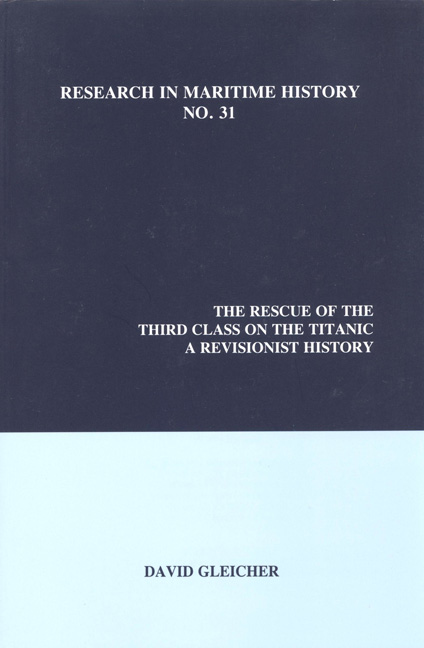Book contents
- Frontmatter
- Dedication
- Table of Contents
- List of Tables in the Text
- List of Illustrations
- Preface
- Notes on the Text
- Introduction
- Chapter 1 The “Popular Story”
- Chapter 2 The Nature Theatre of Oklahoma
- Chapter 3 Except the Rules
- Chapter 4 Departures
- Chapter 5 Like Wild Beasts Ready to Spring
- Chapter 6 Loose Ends
- Chapter 7 A Statistical Study
- Chapter 8 In Conclusion
- Appendix 1 Groupings of Nationalities into Regions
- Appendix 2 Routes to the Lifeboats
- Appendix 3 Deck Plans
- Bibliography
Introduction
- Frontmatter
- Dedication
- Table of Contents
- List of Tables in the Text
- List of Illustrations
- Preface
- Notes on the Text
- Introduction
- Chapter 1 The “Popular Story”
- Chapter 2 The Nature Theatre of Oklahoma
- Chapter 3 Except the Rules
- Chapter 4 Departures
- Chapter 5 Like Wild Beasts Ready to Spring
- Chapter 6 Loose Ends
- Chapter 7 A Statistical Study
- Chapter 8 In Conclusion
- Appendix 1 Groupings of Nationalities into Regions
- Appendix 2 Routes to the Lifeboats
- Appendix 3 Deck Plans
- Bibliography
Summary
More than half of the 1318 passengers on Titanic the night it scraped an iceberg held Third Class tickets. Housed at both extreme ends of the ship, in the bowels of what was the equivalent of a twelve-story floating building, the Third Class passengers were normally kept out of the First and Second Class areas in between. They were excluded as well from the upper decks - notably the Boat Deck where the lifeboats were, as well as A Deck, the First Class Promenade Deck, just below it - the very locations where the main drama of the “popular story” of Titanic has been staged. Who were these Third Class passengers? More than one-third were evenly comprised of British and Irish working class people while a somewhat smaller proportion, about one-quarter of the total, were Scandinavians, mainly Swedes. There were thirty-three Bulgarians on board, all single males, none of whom survived. And there were eighty Syrian/Lebanese passengers, among them entire families. Spanning the cultural differences between the various nationalities was a commonality of “economic class.” Almost all were immigrant workers. Both as individuals and as families they were travelling to work or to join others who were already working in the US, or in some cases Canada. This class aspect is confirmed by the fact that with the notable exception of German nationals, of whom there were only a handful on board, the Third Class passengers came primarily from those European nations that had been sending immigrants to the US since the early nineteenth century: Britain, Ireland, Scandinavia and Austria. This is commonly referred to as the “old immigration.“
These migrant streams initially consisted of “permanent settlers” who wished to put down roots in the fertile economic soil of the mid-nineteenth US. The permanency of the old migration was due in large measure to the nature of the pre-Civil War system of production. The growing manufacturing sector in mid-nineteenth century America was still linked closely to agriculture. Particularly in the Midwest - the nation's agricultural heartland - specialized craftsmen were faced with uneven demand and utilized subsidence agriculture to augment their income. During peak periods such men would draw from agri cultural households for additional labour, while in slack times they relied on their own agricultural production for support.
- Type
- Chapter
- Information
- The Rescue of the Third Class on the TitanicA Revisionist History, pp. xix - xxivPublisher: Liverpool University PressPrint publication year: 2006



